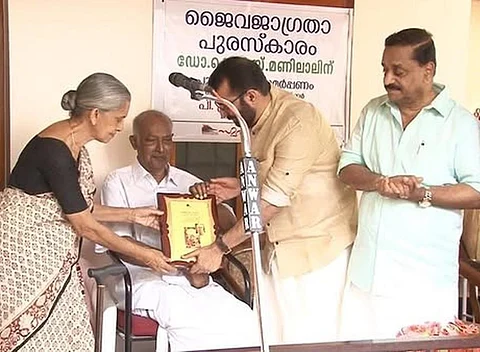

When eminent botanist KS Manilal passed away on New Year’s Day this year, tributes poured in from across the globe, celebrating his unparalleled dedication to translating and interpreting the 17th-century Latin manuscript, Hortus Malabaricus. Spanning 35 years of relentless effort, his work brought this botanical treasure into contemporary relevance.
Manilal, who served as the head of the Botany Department at the University of Calicut, devoted his career to researching, translating, and annotating the 12-volume masterpiece. Originally published in Latin between 1678 and 1693 in Amsterdam, Hortus Malabaricus (literally, The Garden of Malabar) meticulously documents the medicinal plants of Kerala. Manilal’s efforts in modernising this text not only earned him admiration but also rekindled global interest in this monumental work.
The journey began in 1958 when Manilal, still a student, stumbled upon clippings about Hortus Malabaricus in Malayalam newspapers. Later, during postgraduate studies, a visit to the Forest Research Institute in Dehradun introduced him to the complete set of the Latin volumes. The discovery of the 300-year-old Latin book on botany, with names in Malayalam, ignited his imagination.
Despite the daunting task of translating a 2,400-page work, he decided to take it up, viewing it as a bridge between Eastern and Western knowledge systems.
Manilal’s initial hurdle was the Latin language itself. With the help of Father Anthony Mukkath in Kochi, he learnt the basics. Monthly trips to Kochi enabled steady progress until Father Mukkath’s untimely demise. By then, Manilal had gained enough proficiency to tackle the translation independently. Each page took him years to decode and interpret, but his perseverance remained steadfast.
Published in English in 2003 and Malayalam in 2008, Manilal’s translations of Hortus Malabaricus became accessible to researchers, conservationists, and the general public.
His work transformed the manuscript into an invaluable resource for understanding Kerala’s flora, particularly in regions like Silent Valley and Kozhikode, where Manilal conducted groundbreaking biodiversity studies. His meticulous research also contributed to the conservation of these ecosystems.
The original work, conceived by Hendrik Adriaan van Rheede, the Dutch Governor of Cochin in the 17th century, was not merely a botanical catalogue. It offered insights into the socio-cultural and scientific context of its time.
Van Rheede’s motivation included reducing reliance on Arab traders for medicinal plants used by Dutch soldiers. By documenting the region’s flora, he aimed to make Cochin an essential centre for the Dutch East India Company.
Manilal’s role extended beyond translation. He revisited the locations mentioned in the manuscript, identifying 741 plants anew according to modern taxonomic classifications. His collaboration with institutions like the University Grants Commission (1975-1978) and the Smithsonian Institution (1984-1987) enabled extensive fieldwork across Kerala, despite challenges like changing place names and inaccessible forests.
Decoding Hortus Malabaricus involved tracing plants listed in the manuscript back to their original collection sites, as taxonomy had evolved significantly since the 17th century. While the original botanical specimens, reportedly shipped to Amsterdam by Van Rheede, could not be located, Manilal’s team meticulously re-collected the plants from Kerala’s forests. Their fieldwork spanned nearly 500 kilometres, often in treacherous conditions, encountering elephants and venomous snakes.
Manilal’s dedication did not waver even after a stroke in 2006 left him partially paralysed. Undeterred, he learned to type with one hand and completed his final book in 2012. His work on Hortus Malabaricus remains a testament to his resilience and passion.
Manilal’s impact on botany extends far beyond Hortus Malabaricus. Over his career, he published more than 200 research papers and 11 books. Notable works include Flora of Calicut (1982), Flora of Silent Valley (1988), Botany and History of Hortus Malabaricus (1980), and Hortus Malabaricus and the Socio-Cultural Heritage of India (2012). His research led to the discovery of 19 new plant species, four of which bear his name.
In 1989, he founded the Indian Association for Angiosperm Taxonomy (IAAT) and served as its president. He also led the Botanical Society of India and was the editor of Reedia, the IAAT’s journal. These roles cemented his influence on plant taxonomy, a field he revitalised in India.
Manilal’s work earned him numerous accolades. Among them are the Padma Shri (a national honour in India), the Vishwambhar Puri Medal (1990), the YD Tyagi Gold Medal (1998), and the EK Janaki Ammal Taxonomy Award (2003). His international recognition peaked in 2012 when Queen Beatrix of the Netherlands awarded him the Officer of the Order of Orange-Nassau, making him the first Asian recipient of this honour.
Despite retiring in 1999, Manilal remained active in research. He established the Centre for Research in Indigenous Knowledge, Science, and Culture in Kozhikode, which continues to promote Indigenous knowledge through its journal, Samagra.
While his contributions have received limited recognition in India, Manilal remained unperturbed. For him, Hortus Malabaricus was not just a project but a mission to bridge cultures and preserve knowledge. As botanists and researchers worldwide continue to draw from his work, his legacy endures as an inspiration to future generations.
Manilal’s story is one of extraordinary commitment, scholarly rigour, and an unwavering belief in the value of preserving cultural and scientific heritage. His life’s work ensures that Hortus Malabaricus continues to enlighten and enrich the world’s understanding of Kerala’s botanical treasures.